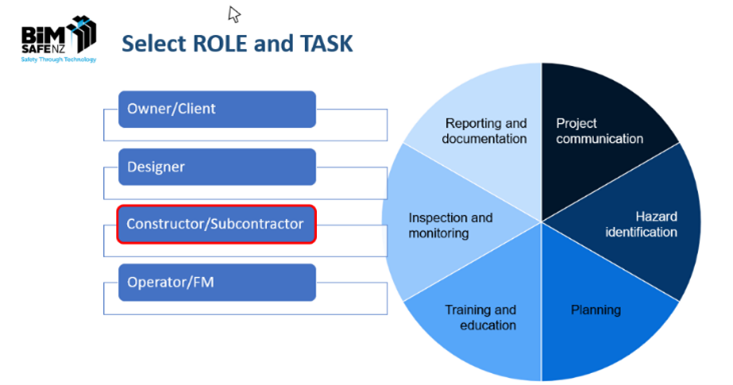A NEW WAY TO LEARN ABOUT BIM AND HEALTH AND SAFETY
The BIMSafe NZ Team is excited to announce a new direction for the project that will help the construction industry to see and use the potential of BIM technology for improving health and safety outcomes.
Rather than producing a static document that would soon become outdated, the project team is developing an interactive web portal that will allow industry users to access information tailored to specific roles and needs. In other words, whereas the initial project intention fell back to traditional, more limited technology and methods, the new approach adopts some of the characteristics of BIM—interactive, visual, customizable, and dynamic—to present information more effectively, and help to keep the content updated and relevant.
The web portal will allow users to focus on their individual role (Client, Designer, Constructor, Operator/FM), as these different groups have different information needs around BIM and health and safety. From within that role, users will select the health and safety task that they want to improve using BIM.
Six key tasks have been defined, based on our research findings, which apply to both horizontal and vertical construction in New Zealand: project communication; hazard identification; planning; training and education; inspection and monitoring; reporting and documentation.

Next, the user will be presented with eight main BIM functions that can help support health and safety activities. The first three of these functions (Model visualization; model interaction; time-based visualisation) address the original BIMSafe focus on communication and visualization, but the scope has been extended to include another five BIM-related .
functions that some New Zealand projects currently use to improve health and safety: reality capture; rule checking; databases/knowledgebases; sensors; simulation.
For each combination of role, task, and function, the user will find an explanation of that specific BIM approach for health and safety, with practical advice for implementation including aspects such as roles, tools and technology, and task requirements. Each selection will also connect to a use case example which illustrates a NZ construction project where the approach has been applied in practice. Another significant change is that the web portal will feature not only the ACC Ōtepoti building as a case study, but also several other significant construction projects that have agreed to share their BIMSafe initiatives with us.
The web portal will eventually be extended to allow users to submit their own case study examples and share their knowledge and experience. This will help to develop a community of users and contributors around the use of BIM in health and safety, and facilitate user-generated content that continues beyond the original scope of the project.
These changes to the original output of the BIMSafe project are significant on many different levels. We believe they will provide greater accessibility and uptake by the industry, and ensure the sustainability and relevance of the material as technology and practice continues to evolve.

